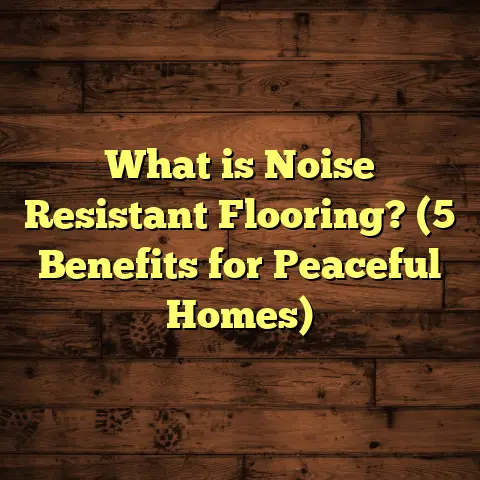What is Landing in Floor Plan? (5 Key Benefits for Home Design)
Durability is something I always keep top of mind when working on home flooring projects. Floors endure so much wear and tear—from heavy foot traffic to moving furniture, spills, and even pets running around. That’s why every detail in a floor plan matters, and one feature I find hugely important but often overlooked is the landing. It’s a small space that can have a big impact on your home’s safety, flow, and even its aesthetic appeal.
I want to talk about what landings are exactly and why they matter so much. Along the way, I’ll share some of my hands-on experiences, data-backed insights, and even how I use tools like FloorTally to make precise cost estimates that help keep projects on budget. If you’re designing a home or planning a remodel, understanding landings could save you time, money, and future frustrations.
What Is a Landing in a Floor Plan?
Let’s start with the basics: what is a landing in a floor plan? In simplest terms, it’s the flat area at the top, bottom, or between flights of stairs where you can pause or change direction. If you imagine walking up a staircase, the landing is that little flat platform where you stop before continuing up or turning another way.
Landings serve several key roles:
- Resting spots: They break long flights of stairs into shorter segments.
- Directional changes: Landings allow stairs to turn corners (usually 90 or 180 degrees).
- Safety zones: They provide places to regain balance and reduce falls.
- Design elements: Landings influence how staircases fit into your home’s layout and style.
Typical Size and Code Requirements
Most building codes require landings for staircases that exceed a certain number of steps to ensure safety. For instance, the International Residential Code (IRC) mandates that:
- Stairs with more than 12 steps must have at least one landing.
- Landings must be at least as wide as the stairs they serve.
- The minimum depth or length of a landing is usually 36 inches (3 feet).
In terms of measurements, landings typically range from 3 feet by 3 feet up to 4 feet by 4 feet or larger, depending on space availability and design needs. For example, in a house I recently worked on, the main staircase had a halfway landing measuring 4 feet by 5 feet to accommodate a 90-degree turn and allow enough room for two people to comfortably pass.
In urban homes with limited space, landings might be smaller but still meet code minimums. In larger homes or luxury builds, landings can become mini “rooms” in themselves—sometimes featuring built-in benches, plants, or even small bookshelves.
Placement and Location
Landings appear in several common locations:
- Bottom of stairs: This landing transitions from floor to stair.
- Top of stairs: Where stairs meet the next floor level.
- Between flights: Midway points in longer staircases where stairs change direction.
- Split-level homes: Landings separate different levels or zones within the home.
How you place landings affects not just safety but also how natural the traffic flow feels. A poorly placed landing can create bottlenecks, while a well-designed one feels like a natural pause point.
Why Do Landings Matter? 5 Key Benefits for Home Design
From my years working in flooring and home renovations, I’ve seen firsthand how adding well-thought-out landings improves homes in ways many homeowners don’t expect.
1. Safety and Comfort Go Hand in Hand
Safety is probably the most obvious advantage of including landings. When I work with clients who have kids or elderly family members, this is always top of mind.
Long staircases without landings can be exhausting to navigate. Imagine climbing 15 straight steps—your legs get tired, your balance wobbles, and the risk of tripping increases. Landings provide a natural break where you can stop, regain balance, or even set down heavy items safely.
I remember one job where we renovated an old farmhouse with very steep stairs—no landings at all. The homeowners wanted us to improve safety without completely rebuilding the staircase because of budget constraints. Adding one small landing halfway up made a huge difference. Suddenly, the climb felt less daunting and much safer for their young children.
According to the National Safety Council, falls are the leading cause of home injury deaths among older adults over age 65. Stairs are often involved. So having landings that meet or exceed code requirements is not just smart—it’s essential for protecting your loved ones.
2. More Efficient Use of Space
I can’t tell you how many times I’ve seen clients struggle with fitting staircases into tight homes. Landings offer design flexibility that helps make the most of available space.
For example, L-shaped staircases with a landing allow you to fit stairs neatly into corners rather than running straight down a hallway. This layout often opens up floor space for other uses.
In one urban townhouse I remodeled last year, we used a U-shaped stair with two landings to fit three floors into a narrow footprint. The landings not only allowed the stairs to turn but also created visual interest when we added custom lighting and flooring accents.
Space-wise, landings usually add about 12 to 20 square feet per platform but save room overall by letting you stack shorter flights vertically instead of spreading long staircases out horizontally.
3. Smoother Traffic Flow
Have you ever bumped into someone on stairs because there was no room to pass? That’s where landings really shine.
In multi-person households or homes that entertain often, landings give you space to pause or pass without awkward moments. This is especially true for wider landings (around 4 feet or more), which allow two people to stand side by side comfortably.
In one duplex project I completed recently, the staircase served as the main route between two family units sharing a common entryway. Without a landing mid-way for anyone coming down to step aside or wait, it was chaotic during busy times.
The landing created an informal waiting area that improved flow dramatically—plus it looked great with new flooring and decor.
4. Adds Value and Appeal
Here’s something many homeowners don’t realize: landings contribute to perceived build quality and overall home value.
Real estate agents often mention staircases as key features buyers notice immediately. A staircase with a well-designed landing feels safer and more inviting than a long straight run with no breaks.
According to remodeling industry reports, kitchen and bathroom upgrades top ROI lists—but well-executed staircases can increase resale value by 3-5%, particularly in multi-story homes where stairs are central features.
When clients ask me if adding landings is “worth it,” I tell them these subtle design choices often pay off both in daily life enjoyment and future sale potential.
5. Easier Installation & Maintenance
From my perspective as a flooring contractor who has installed thousands of square feet on stairs and landings, these flat platforms make the job easier in some ways.
Why? Because landings give installers natural break points where they can switch flooring types or patterns without awkward transitions on steps themselves.
For example, in one recent project we used hardwood treads on the stairs but installed durable tile flooring on the landings to resist wear better in high-traffic zones. This combination kept costs reasonable without sacrificing style or durability.
Landings also simplify repairs later; if a section gets damaged or worn out, it’s easier to isolate repairs without disturbing entire stair runs.
Detailed Insights From My Flooring Projects Involving Landings
Over the years, I’ve worked on hundreds of projects involving stairs and landings—each offering unique lessons. Let me share some detailed experiences that illustrate why I recommend prioritizing landings early in your design process.
Case Study: Urban Townhouse Stair Remodel
I worked with clients renovating a narrow three-story townhouse with existing straight-run stairs that felt cramped and unsafe. They wanted to create a more open feel while keeping costs manageable.
We designed an L-shaped staircase with an intermediate landing measuring 4 feet by 4 feet. This allowed the stairs to turn 90 degrees halfway up—which saved about 15 square feet compared to extending straight stairs fully along the wall.
The landing became a feature spot where we installed patterned tile contrasting with oak hardwood treads—adding character while improving traction where foot traffic was heaviest.
Using FloorTally helped me estimate materials precisely: hardwood for treads and risers plus tile for landing took about 120 square feet total including waste factor (usually around 10%). Labor estimates came in at roughly $1,200 for installation based on local rates—right on target with client budget expectations.
Data Point: Staircase Dimensions & Safety Compliance
- Minimum tread width: 10 inches
- Riser height range: 7 to 7 3/4 inches
- Minimum landing dimension (width & depth): 36 inches
- Stair width minimum: Typically 36 inches (wider preferred for comfort)
These numbers come from IRC standards but vary slightly by region. I always double-check local codes before starting any project because compliance avoids costly rework later.
Cost Breakdown Example for Stairs with Landing Installation
- Materials:
- Hardwood flooring: $6-$10 per sq ft
- Tile flooring: $3-$8 per sq ft
- Subfloor & underlayment: $1-$2 per sq ft
- Labor:
- Stair installation: $50-$75 per step
- Landing installation: Additional $200-$400 depending on size/materials
- Additional:
- Waste factor: Usually add ~10% extra material
- Finishing & trim: $200-$600 depending on details
For an average staircase with one landing (about 15 steps total), total costs hover between $2,500 and $6,000 depending on materials chosen and complexity of design.
Why Using Tools Like FloorTally Makes My Job Easier
Estimating flooring projects accurately can be tricky—especially with multiple materials and tricky areas like stairs plus landings involved.
FloorTally has become my go-to tool because it consolidates all calculations into one place:
- Input room dimensions including stair lengths & landing sizes.
- Select materials from wide options (hardwood types, tiles, laminates).
- Specify waste factors to avoid running short.
- See local labor cost estimates based on real market data.
This saves me hours that I’d otherwise spend cross-checking suppliers and contractors for quotes. It also helps me give clients realistic budgets upfront—which avoids surprises later.
When calculating our townhouse project costs mentioned above, FloorTally showed material needs within a fraction of an inch accuracy plus labor estimates broken down by task—making planning simple and efficient.
More Personal Thoughts About Landings
Thinking about landings reminds me of how small details shape our everyday living experience. When designing or renovating your home, focus on these thoughtful elements just as much as big features like countertops or lighting.
A well-placed landing isn’t just about safety—though that alone is reason enough—it’s about flow, comfort, style, and even how your home feels welcoming when friends visit.
One time during installation of that farmhouse staircase I mentioned earlier, I watched an elderly client pause on the new landing mid-climb just to look out their window—a spot we positioned perfectly for natural light. That moment highlighted how something as simple as adding flat space between steps can create unexpected joy in daily routines.
Final Thoughts: Should You Include Landings?
If you’re considering stairs for your home:
- Ask yourself how many steps you’ll have continuously.
- Think about who will use those stairs most often.
- Consider what kind of traffic flow works best for your lifestyle.
- Check your local building codes carefully.
In most cases I’ve seen—and experienced firsthand—adding at least one well-sized landing improves both function and form dramatically.
If budget is tight but safety matters (and it should!), prioritize landings early in your design conversations with architects or contractors before finalizing plans.
If you have questions about specific materials for stair landings or want help estimating costs for your project using tools like FloorTally, feel free to ask! I’m happy to share more detailed advice tailored to your situation.
Have you ever noticed how having just a little extra flat space on stairs changes how comfortable they feel? Sometimes it’s these small details that make all the difference between a house that feels like home—and one that doesn’t quite get there.





